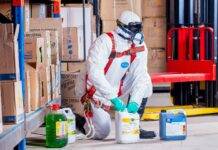
Chemical Engineering Safety Moments: Enhancing Safety Culture in the Workplace
Chemical engineering safety is paramount in any industry where the handling, processing, or manufacturing of chemicals is involved. It encompasses a set of principles, practices, and protocols aimed at minimizing risks, preventing accidents, and ensuring the well-being of workers and the environment. In this article, we delve into the concept of safety moments and explore how they contribute to fostering a culture of safety within the realm of chemical engineering.
Understanding Chemical Engineering Safety
Definition of Chemical Engineering Safety
Chemical engineering safety refers to the systematic approach of identifying, assessing, and mitigating risks associated with chemical processes and operations. It involves implementing measures to prevent accidents, injuries, and environmental harm while promoting the safe handling, storage, and disposal of hazardous materials.
Key Principles of Chemical Engineering Safety
The principles of chemical engineering safety revolve around hazard identification, risk assessment, risk management, and continuous improvement. These principles guide engineers and operators in designing, operating, and maintaining systems that minimize the potential for accidents and ensure the safety of personnel, equipment, and the surrounding community.
Common Hazards in Chemical Engineering
Chemical engineering encompasses various hazards, including chemical exposure, fire and explosion risks, process malfunction, equipment failure, and environmental contamination. Understanding and mitigating these hazards are essential for maintaining a safe and sustainable work environment.
The Concept of Safety Moments
Definition and Purpose of Safety Moments
Safety moments are brief, informal discussions or presentations focused on a specific safety topic or concern. They serve as opportunities to raise awareness, share experiences, reinforce safety protocols, and promote a collective commitment to safety among employees.
How Safety Moments Enhance Safety Culture
Safety moments play a crucial role in enhancing safety culture by encouraging open communication, active participation, and continuous learning. They provide a platform for employees to voice concerns, share insights, and suggest improvements, fostering a sense of ownership and accountability for safety within the organization.
Examples of Effective Safety Moments
Effective safety moments can cover a wide range of topics, from highlighting near misses and lessons learned to introducing new safety procedures or equipment. They can incorporate real-life examples, interactive activities, multimedia resources, and storytelling techniques to engage participants and drive home key safety messages.
Incorporating Safety Moments in Chemical Engineering
Importance of Regular Safety Briefings
Regular safety briefings, including safety moments, are essential for keeping safety top of mind and reinforcing safe work practices. They should be conducted at the beginning of shifts, meetings, or specific work tasks to ensure that employees are adequately informed and prepared to mitigate risks effectively.
Strategies for Implementing Safety Moments
Implementing safety moments requires a proactive approach, clear communication, and leadership support. Organizations can designate safety champions or committees responsible for planning, facilitating, and evaluating safety moments, ensuring their relevance, effectiveness, and sustainability.
Tools and Resources for Creating Impactful Safety Moments
Various tools and resources are available to facilitate the creation and delivery of impactful safety moments, including safety observation cards, toolbox talks, safety videos, and online training modules. Leveraging these resources can help tailor safety moments to specific audiences, environments, and safety objectives.
Case Studies of Successful Safety Moments
Case Study 1: Reducing Accidents in a Chemical Plant
In a chemical plant, regular safety moments focused on proper equipment maintenance and emergency response procedures resulted in a significant reduction in accidents and incidents over time. By empowering employees to identify and address safety concerns proactively, the plant fostered a culture of safety excellence.
Case Study 2: Improving Safety Awareness in a Research Lab
In a research lab setting, weekly safety moments addressing laboratory hazards, chemical handling protocols, and personal protective equipment usage contributed to improved safety awareness and compliance among researchers. As a result, the lab experienced fewer incidents and near misses, enhancing overall productivity and morale.
Case Study 3: Enhancing Safety Communication on an Offshore Rig
On an offshore rig, daily safety moments focused on teamwork, communication, and hazard recognition fostered a collaborative safety culture among crew members. By encouraging open dialogue and sharing best practices, the rig achieved a significant reduction in safety incidents and downtime, ensuring operational efficiency and reliability.
Here's a safety moment tailored for chemical engineering:“Good morning everyone,
Today, let’s talk about the importance of safety in our chemical engineering practices. As chemical engineers, we work with various substances and processes that can present hazards if not handled properly. Whether it’s designing processes, conducting experiments, or operating equipment, safety should always be our top priority.
One key aspect of chemical engineering safety is understanding the properties and potential risks associated with the chemicals we work with. Before starting any task, it’s crucial to familiarize ourselves with the Material Safety Data Sheets (MSDS) or Safety Data Sheets (SDS) for the chemicals involved. These documents provide valuable information on hazards, handling, storage, and emergency procedures.
Another critical aspect is maintaining a clean and organized workspace. Clutter and spills can increase the risk of accidents, so be sure to clean up any spills promptly and store chemicals properly when not in use.
Additionally, always use personal protective equipment (PPE) appropriate for the task at hand. This may include gloves, goggles, lab coats, or respirators depending on the chemicals and processes involved. Never take shortcuts when it comes to PPE – it’s your first line of defense against potential hazards.
Lastly, don’t hesitate to speak up if you notice any safety concerns or if you’re unsure about how to safely proceed with a task. Communication is key to maintaining a safe working environment for everyone.
Remember, safety is not just a priority – it’s a value that should be integrated into everything we do as chemical engineers. By prioritizing safety, we can prevent accidents, protect ourselves and our colleagues, and ensure the success of our projects.
Thank you for your attention, and let’s all commit to working safely every day.”
Benefits of Prioritizing Safety Moments
Reduction in Accidents and Incidents
By incorporating safety moments into daily operations, organizations can proactively identify and address potential hazards, leading to a reduction in accidents, injuries, and near misses. This not only protects employees and assets but also minimizes downtime and liability risks.
Fostering a Culture of Safety and Accountability
Safety moments promote a culture of safety and accountability by empowering employees to take ownership of their safety and that of their colleagues. When safety becomes everyone’s responsibility, individuals are more likely to adhere to protocols, report hazards, and intervene when necessary to prevent accidents.
Long-Term Cost Savings and Productivity Gains
Investing in safety moments yields long-term cost savings and productivity gains by minimizing workplace injuries, property damage, and regulatory fines. By prioritizing safety, organizations can enhance employee morale, retention, and productivity while safeguarding their reputation and bottom line.
Conclusion
Chemical engineering safety moments play a vital role in enhancing safety culture, preventing accidents, and fostering continuous improvement in the workplace. By incorporating safety moments into daily operations and promoting open communication and collaboration, organizations can create safer, healthier, and more productive work environments for all stakeholders.
Chemical Hygiene in Laboratories: Promoting Safe Handling and Storage Practices
Chemical Handling: Storage and Personal Protective Equipment (PPE)
Chemical Exposure Monitoring: Air Sampling and Analysis
Chemical Spill Response: Containment and Cleanup
Hazardous Materials Transportation: Compliance and Emergency Response
FAQs (Frequently Asked Questions)
- What is the difference between a safety moment and a safety meeting? Safety moments are brief, informal discussions focused on a specific safety topic or concern, typically lasting a few minutes. In contrast, safety meetings are more formal gatherings that may cover multiple safety topics, involve presentations or training sessions, and require scheduled time and participation from all attendees.
- How often should safety moments be conducted? The frequency of safety moments can vary depending on organizational needs, industry regulations, and operational priorities. However, it is generally recommended to conduct safety moments regularly, such as daily or weekly, to reinforce safety messages, address emerging hazards, and maintain a strong safety culture.
- Who should lead safety moments? Safety moments can be led by anyone within the organization, including frontline workers, supervisors, safety coordinators, or designated safety committees. The key is to ensure that the individual leading the safety moment is knowledgeable about the topic, engages participants effectively, and fosters open dialogue and participation.
- How can organizations measure the effectiveness of safety moments? Organizations can measure the effectiveness of safety moments through various methods, including participant feedback, safety performance indicators, incident reports, and trend analysis. By collecting data and soliciting input from employees, organizations can assess the impact of safety moments on safety awareness, behavior, and outcomes.
- What are some tips for creating engaging safety moments? To create engaging safety moments, consider using real-life examples, interactive activities, multimedia resources, and storytelling techniques to capture participants’ attention and drive home key safety messages. Encourage active participation, ask open-ended questions, and provide opportunities for discussion, reflection, and feedback to make safety moments more meaningful and impactful.
























